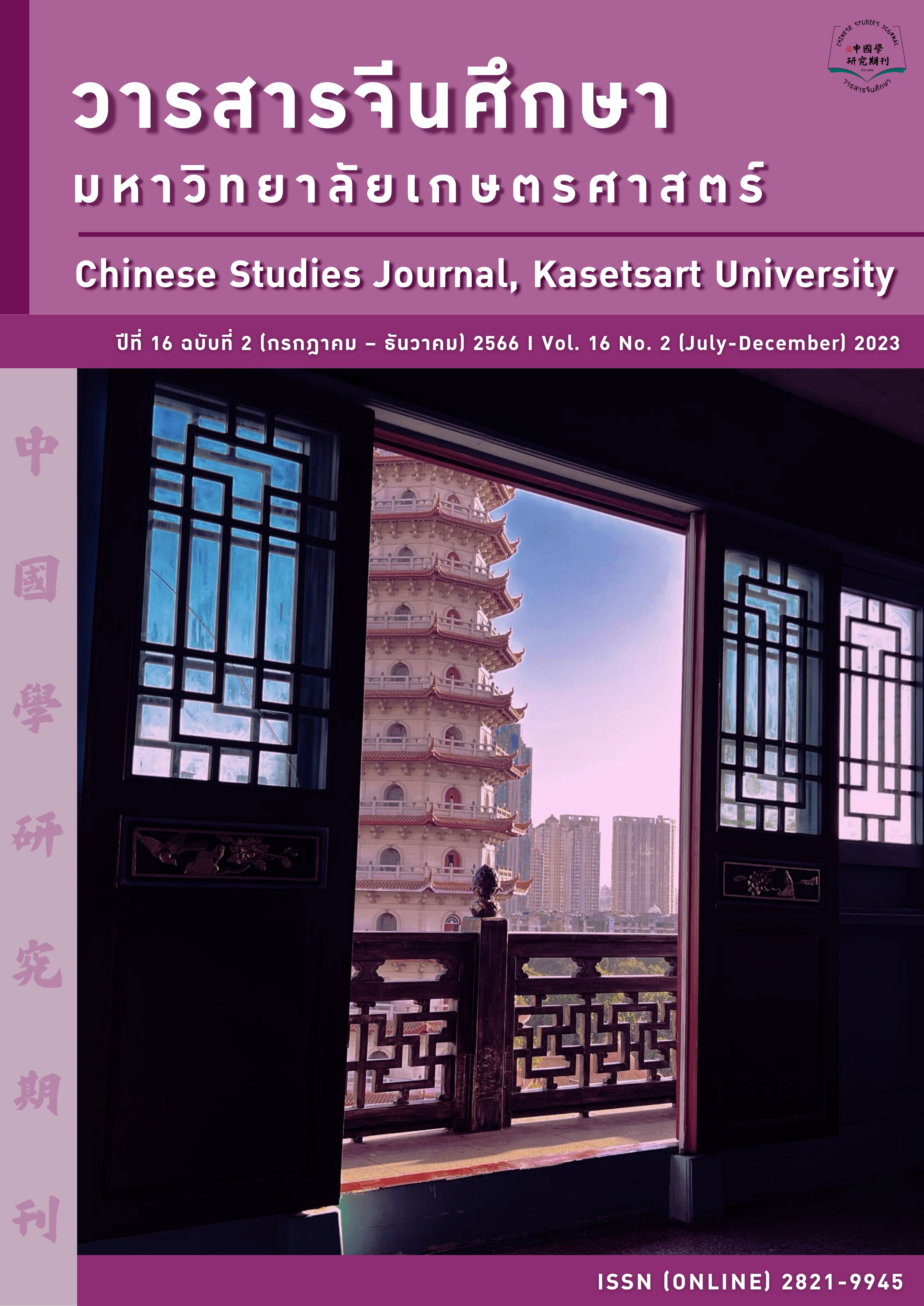Imaginative Geographies and the Identity Transformation of Chinese Diaspora Characters in Qiongyao’s 1960-1970’s Romance Novels ภูมิทัศน์จินตกรรมและการเปลี่ยนแปลงอัตลักษณ์ของตัวละครชาวจีนพลัดถิ่น ในนวนิยายโรมานซ์ของฉยงเหยาในทศวรรษที่ 1960-1970
Main Article Content
Abstract
This research paper aims to study the imaginative geographies of Mainland China, Taiwan and Western countries, and the identities of Chinese diaspora characters in Qiongyao’s romance novels during half of 1960-1970 decades. The theories of Orientalism and the concept of imaginative geographies, the link between the novel and the modern nation-state, and the concept of cultural identity and diaspora were applied in this study. The study found out that, Mainland China was depicted as a nostalgic place, full of happiness and nature. Whereas Taiwan was written as a place of the present, full of issues, and an urban space, influenced by American culture. The western countries were portrayed as places of opportunities and refuge, with inhabitants characterized by distinct races, languages, and cultures differing from those in Taiwan. Qiongyao wrote Mainland China and western countries as the past and the future to project Taiwan as the present. The research also found that, in her novels from 1960’s, Mainland China was portrayed as the homeland of the first-generation Chinese diaspora characters. However, the novels from 1970’s Taiwan was more frequently referred to as home by the second-generation of Chinese diaspora characters. This change in perception of one’s homeland coincided with transformation of role of the two generations in Qiongyao’s novels after 1970. In contrast to the first-generation, who saw Taiwan more as a temporary sanctuary than a homeland, the second-generation characters considered Taiwan as their homeland.
Article Details

This work is licensed under a Creative Commons Attribution-NonCommercial-NoDerivatives 4.0 International License.
ผลงานทางวิชาการที่ลงตีพิมพ์ในวารสารจีนศึกษา มหาวิทยาลัยเกษตรศาสตร์ เป็นลิขสิทธิ์ของผู้เขียนหรือผู้แปลผลงานนั้น หากนำลงในวารสารจีนศึกษาเป็นครั้งแรก เจ้าของผลงานสามารถนำไปตีพิมพ์ซ้ำในวารสารหรือหนังสืออื่นได้โดยมิต้องแจ้งให้ทราบล่วงหน้า แต่หากผลงานที่ได้รับพิจารณานำลงในวารสารจีนศึกษา เป็นผลงานที่เคยตีพิมพ์ที่อื่นมาก่อนเจ้าของผลงานต้องจัดการเรื่องปัญหาลิขสิทธิ์กับแหล่งพิมพ์แรกเอง หากเกิดปัญหาทางกฎหมาย ถือว่าไม่อยู่ในความรับผิดชอบของวารสารจีนศึกษา มหาวิทยาลัยเกษตรศาสตร์ ทั้งนี้ ความคิดเห็นต่างๆ ในบทความเป็นความคิดเห็นส่วนตัวของผู้เขียน ไม่เกี่ยวกับกองบรรณาธิการวารสารจีนศึกษา มหาวิทยาลัยเกษตรศาสตร์
References
Anderson, B. R. O. G. (2016). Imagined communities : reflections on the origin and spread of nationalism (Rev. ed ed.). Verso.
Cohen, R. (2008). Global Diaporas an Introduction (second edition ed.). Routledge.
Hall, S. (1990). Cultural Identity and Diaspora In J. Rutherford (Ed.), Identity: Community, Culture, Difference (pp. 222-237). Lawrence & Wishart.
McLeod, J. (2010). Beginning postcolonialism (Second edition ed.). Manchester University Press.
Moretti, F. (2016). Atlas of the European novel, 1800-1900. Verso.
Rubinstein, M. A. (2015). Taiwan’s Socioeconomic Modernization, 1971-1996. In M. A. Rubinstein (Ed.), Taiwan: A new history (pp. 366-402). Routledge.
Safran, W. (2004). Deconstructing and comparing diasporas. In W. Kokot, K. Tölölyan, & C. Alfonso (Eds.), Diaspora, Identity and Religion (pp. 9-29). Routledge.
Said, E. (2003). Orientalism (25th anniversary ed.). Penguin Books.
Wang, P. C.-m. (2015). A Bastion Created, A Regime Reformed, An Economy Reengineered, 1949-1970. In M. A. Rubinstein (Ed.), Taiwan: A new history (pp. 320-338). Routledge.
中国当代通俗小说史论. (2007). (汤哲声, Ed.). 北京大学出版社.
侯如绮. (2014). 双乡之间: 台湾外省小说家的离散与叙事 (初版 ed.). 联经.
林季颖. (2020). 琼瑶七〇年代小说的空间书写研究. [硕士学位论文]. 国立高雄师范大学.
琼瑶. (2018a). 一帘幽梦. 湖南文艺出版社.
琼瑶. (2018b). 人在天涯 (V001.0001 ed.). 春光.
琼瑶. (2018c). 几度夕阳红. 湖南文艺出版社.
琼瑶. (2018d). 在水一方. 湖南文艺出版社.
琼瑶. (2018e). 庭院深深. 湖南文艺出版社.
琼瑶. (2018f). 月朦胧鸟朦胧. 湖南文艺出版社.
琼瑶. (2018g). 海鸥飞处. 湖南文艺出版社.
琼瑶. (2018h). 烟雨濛濛. 湖南文艺出版社.
邓津华. (2018). 台湾的想像地理: 中国殖民旅游书写与图像 (杨雅婷, Trans.). 台湾大学出版中心.
陈犀禾、王雁. (2010). 论琼瑶的电影的中国性与台湾图像. 上海大学学报(社会科学版), 17(1).
陈致锋. (2017). 接受与认同:琼瑶文学作品对两岸共通意义空间的建构. 哈尔滨工业大学学报(社会科学版), 19(5), 88-93.
龙文彬、黄国柟. (2002). 台湾及两岸三地华人人口推估方法-理论勾践与实证探讨(以美国为例). 中华民国侨务委员会.


